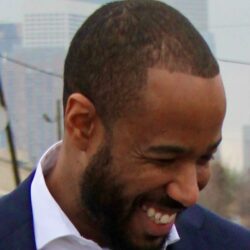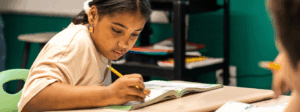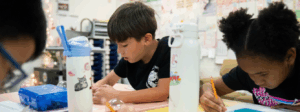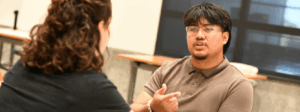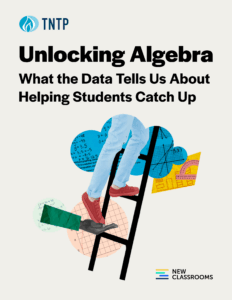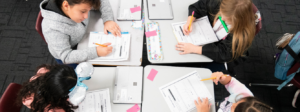High-impact tutoring (HIT), commonly referred to as high-dosage tutoring, is gaining momentum as a research-based instructional strategy that can help school districts address unfinished learning from the COVID-19 pandemic. While we know that HIT has great potential for students, the question of how to scale it to benefit all students remains unanswered.
Guilford County Schools (GCS), a TNTP partner, may have a solution that can help to scale its HIT program—and strengthen its teacher pipeline. GCS formed a partnership with North Carolina Agricultural and Technical State University (North Carolina A&T)–the HBCU that produces the most Black engineers in the U.S.–to recruit graduate students to staff their HIT program and hopefully consider careers in education. GCS is making a compelling case for why HIT should be a practice policymakers and educators alike should continue to explore beyond the pandemic.
We spoke to Faith Freeman, GCS’s director of STEM, about this work and how their partnerships with institutions of higher education have helped drive it.
Q: Thanks for speaking to us today. Faith, tell us about GCS. What makes it a unique place?
A: I would say our approach to giving students and families access to different programs. GCS is thinking about different ways to impact people, and not just impacting people right now, but also for generations to come. I personally appreciate the thinking of our Superintendent, Dr. Sharon Contreras, and our Deputy Superintendent, Dr. Whitney Oakley.
Q: How did Guilford County School determine that HIT was a priority that would improve student learning?
A: Our Superintendent knows and understands the research. There was a lot of research showing that a lot of learning would be lost, specifically in math, and especially in secondary math. There were academic gaps that existed prior to the pandemic. The pandemic only widened those gaps.
We asked ourselves, based on the research, “What can we do to close those academic gaps?” The research led us to HIT, so that was the beginning of our program.
Q: Tell us about your partnership with North Carolina A&T. When did it begin and how did it begin?
A: Our partnership began a little over a year ago. We started out small with maybe about 13 to 15 graduate assistants [who tutored high school students in math]. Now, we have approximately 40 graduate assistants.
I am the director of STEM, so I had pre-established partnerships with local colleges and universities because of my work in that role. We were then able to expand those partnerships and leverage them to support our HIT program. Now, we work directly with the College of Education at North Carolina A&T to recruit graduate students.
Q: What did you learn from the early stages of your partnership with North Carolina A&T?
A: Our biggest lesson is the need to have a liaison at the college, and here, at GCS, on the district side. We have liaisons with our college partners, so they can help us manage students on the college end, which we found is very important.
I think that’s the biggest lesson learned. It is very important for our college liaisons to not only communicate information, but also to reiterate that information to graduate students too.
It’s also important for the graduate assistant to go through coaching [tutoring] coursework which is part of their graduate assistantship. Overall, having a partner on both sides shows that both institutions are in it together, and that this initiative isn’t only “a GCS thing” and that it isn’t only “a North Carolina A&T thing.” It’s something both institutions are invested in together.
Q: What barriers did you encounter in this partnership? How did you overcome these barriers?
A: I think learning each other’s paperwork has been a big thing! I have been fortunate to not only have people on the GCS side to help navigate, but also people on the university side who helped me navigate. The navigation hasn’t always been smooth. But I appreciate that everybody wants this partnership to work, and they are working hard to make it work.
This is how communities should be—you have a school district and a university. These two entities should be working together to create a pipeline of future educators. Why can’t they work together?
In our program, we don’t just have education majors, or just business majors, or just engineering majors. We have tutors who could go into a variety of industries. That creates powerful connections that benefit students. GCS is opening its doors and showing what’s happening in our schools and how it impacts so many people.
Q: How has the partnership with North Carolina A&T influenced the effectiveness of your HIT program?
A: Most of the graduate assistants go into our high schools. Students love them! Principals have called me and said, “Faith, I wasn’t too sure about these college students coming into my building, but I was wrong.” It’s not only the academic piece that this partnership influences. The graduate assistant tutors are close in age to the high school students; many of our graduate assistant tutors are students of color, and we are in a district where the majority are students of color. So having someone who looks like you, and who’s close to your age, come to your school and tutor you in math makes you want to go to the tutoring session. We had instances where teachers said students were upset if a tutor couldn’t make it that day.
So, it’s not just the academic effect but also the social-emotional influence and mentorship piece that have been huge for us. Students have a person they can relate to, so they want to go to tutoring. Our graduate assistants tutor at juvenile detention centers and experience the same thing there—students do not want to miss a tutoring session—and they are willing to do what’s expected of them to attend tutoring.
Q: Do you think this partnership has the potential to help address teacher shortages?
A: I do! I had an engineering graduate who emailed me and said, “I have decided to go get my master’s degree in education.” So now we have a Black female engineer deciding to go and teach secondary math. This past semester we had college juniors and seniors tutor in our schools. They have even talked about being educators because they see the affect they’re having on students.
Our tutors have a class attached to their tutoring hours. When I read their journals, I see how their perspective has changed and how it’s affected them because they feel like they are doing something good for the students.
We hear from many graduate students about how much this experience has changed them.
Q: What advice would you give other school districts about partnership with colleges and universities?
A: I would say communication is key. We talked with North Carolina A&T’s liaison on a weekly basis, sometimes on a daily basis, to work through things. Communication is the key.
Being flexible is important too and having that flexibility to navigate our work is another big thing!
Q: When considering the partnership between GCS and North Carolina A&T, what are you most proud of?
A: I would probably say that I am most proud of being able to expand as much as we have. Last year, we had 12 tutors and now we have a little more than 40. Next year, we are going to have approximately 80. Being able to have that number of graduate assistants tutoring our students will be big, and I am proud of the strong impact that our tutors are having at schools. That’s what I’m most proud of.

